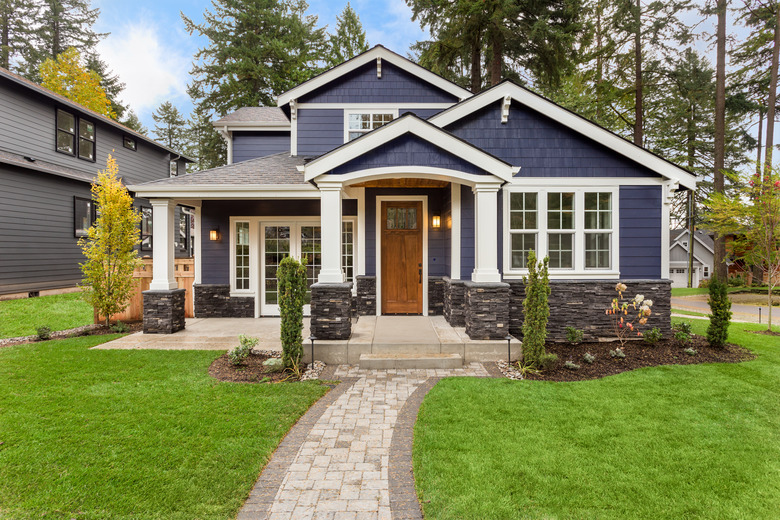What Does A Home Appraiser Look For?
Whenever you buy or refinance a home — in other words, whenever you need a mortgage loan — you need a home appraisal, which is an independent evaluation of the home's value. Every mortgage lender requires an appraisal to guarantee that it isn't financing a property for more than it's worth because if that were to happen, the lender couldn't recoup its investment in case it has to foreclose and sell the property. Impartiality is key, so the home appraiser is a neutral third party with no connection to either the lender or the borrower.
During the homebuying process, the home appraisal typically happens after the seller accepts the buyer's offer, and although the lender usually arranges it, the buyer is the one who pays for it. The cost of a home appraisal is between $300 and $500 depending on the size and complexity of the property, and most people will end up paying just over $330. Sometimes, the buyer has to come up with that money out of pocket, but it can also be tacked on to the closing costs. During a refinance, the homeowner pays for the appraisal, which must occur before the new loan is approved.
A home appraisal can be stressful affair because it can make or break a real estate deal. It isn't unusual for a sale or refinance to fall through because the appraised value of the house came in lower than the agreed-upon purchase price or requested mortgage amount. Although many characteristics of a property that affect its appraised value are fixed, homeowners do have control over important ones that can raise the appraised value by giving the appraiser a good impression.
Tip
A home appraiser looks at the overall condition of the home, its inherent features and compares it to similarly sized homes in the area to come up with an appraised value.
A Home Appraisal Is a Professional Opinion
A Home Appraisal Is a Professional Opinion
While an appraisal is a thorough valuation of a property considering both the interior and exterior of the home, it isn't the same as a home inspection. Unlike a home inspector, an appraiser doesn't have an eye toward home improvements and repairs. The appraiser is solely concerned with assigning a fair market value to the property based on its condition as well as the selling prices of comparable properties in the neighborhood. The appraisal report constitutes an opinion, but it's one that can have drastic consequences, and a homeowner who was hoping for a higher appraised value does have recourse, including asking for a re-evaluation or seeking a second opinion.
Home appraisers are licensed professionals with 75 or more hours of training who have, depending on the state, passed a state-certified home appraisal exam. To guarantee impartiality, it's illegal for an appraiser to have any interest in the financial particulars of the sale or refinance or to have any personal connection with the parties involved.
Appraisers adhere to the Uniform Standards of Professional Appraisal Practice published by the Appraisal Foundation, and lenders typically hire them through a neutral third party called an appraisal management company (AMC). The number of AMCs has grown since 2010, when Congress passed legislation to prevent the practice of inflating home values to make it easier for lenders to approve mortgages.
A Home Appraisal Doesn't Take Long
A Home Appraisal Doesn't Take Long
A home appraisal can last anywhere from 30 minutes to 3 hours depending on factors like the size of the property and its overall condition. In some cases, such as when appraising a large, older home in a historical district, an appraisal can take several days.
During the appraisal process, an appraiser will take measurements and calculate square footage, conduct a visual inspection and enter notes on an appraisal form, most often a standard one, such as Fannie Mae's Uniform Residential Appraisal Report. In determining the appraisal value, the appraiser also checks the prices of comparable properties within a fixed radius (often a mile or two) that have sold during the last few weeks or months.
After completing the inspection, the appraiser presents the appraisal report to whomever paid for it (typically homebuyers or homeowners who are refinancing) as well as the lender, and the lender makes its decision on whether or not to grant the loan based on the home's value. The lender can decline the loan if the appraised value is lower than the loan amount, although if it's just a bit lower, the buyer has the option of increasing the down payment to make up the difference.
If the appraised value is very low, the onus is usually on the seller to lower the price for the deal to move forward. Buyers can also have an appraisal contingency in their contract, which means that if the house appraises for lower than the purchase price, they can walk away from the sale with their earnest deposit in hand.
Appraising the Exterior of a Home
Appraising the Exterior of a Home
Some of the factors the appraiser considers when assessing the exterior of a home include legal designations that can be obtained from public records, such as property lines, zoning and the availability of essential utilities, the latter of which is particularly important when evaluating rural properties.
The characteristics of the surrounding neighborhood — whether it's rural, urban or suburban and quiet or noisy — are noted. The neighborhood is one of the main determinants of home values, and it is reflected in comparable home prices, which are part of the appraiser's assessment. An appraiser might also consider landscaping features, such as privacy trees or a rock garden, if they contribute permanent value that will benefit a new occupant.
In addition, the appraiser considers the overall condition of the structures, including the materials and state of repair of
- Roofing
- Siding and trim
- Gutters
- Driveway and walkways
- Fences
The appraiser looks for any defects or problems that could affect the structural integrity of the building to make it less livable and also notes upgrades, such as a brand-new roof or deck, that have a positive effect on the property's value. Only permanent features are considered, so an in-ground swimming pool would be included in the appraisal report, whereas an above-ground pool or a hot tub that the owners could sell or take with them when they move would not be included. Although some items, such as hot tubs, aren't included in the appraisal report, they aren't without value because they are desirable and can make the property more marketable, but that's a nonissue for the appraiser.
Appraising a Home's Interior
Appraising a Home's Interior
Inside the home, the appraiser measures the square footage of each room and notes the general layout of the floor plan, including the number of bedrooms and bathrooms, whether or not there's a basement and whether or not it's usable. The appraiser makes special note of any part of the house that has undergone a recent remodel and any recent upgrades to the home's HVAC, electrical or plumbing systems that make the home more functional and up to date. Also important is the condition of the cabinets, countertops, floors and other built-in features, such as stairways, fireplaces and skylights as well as the materials used for them.
A hardwood floor and stone countertops in good condition are likely to lift the appraisal value, whereas old carpet and stained laminate countertops will have the opposite effect. Other detracting items would include peeling wall paint, musty smells indicating the presence of mold and sticking doors, which could indicate foundation problems. Some interior features, such as ceiling fans, window shutters and mirrors, may make the home more comfortable but wouldn't be included in the appraisal because, like hot tubs, they are technically movable.
Assessing a Home's Value
Assessing a Home's Value
Before setting foot on a property, home appraisers will study the recent home sales history in the neighborhood to get a general valuation range. If the purchase price of a nearby home of comparable value that sold two weeks ago was $330,000, and another comparable home sold for $350,000 a month before, that gives an appraiser an average market value of neighborhood homes to use as a reference. Now, it's a question of adding and subtracting from that value according to features and defects noted on the subject property.
Besides structural and cosmetic characteristics of the property, the appraiser also takes into account tangible and intangible features that affect the desirability of the property, such as:
- Overly personalized interior features that don't have general appeal
- Curb appeal or lack thereof and how well the house fits in the neighborhood
- The presence of energy-efficient appliances
- Busy nearby thoroughfares that make the neighborhood noisy
- Abandoned houses or derelict structures in the neighborhood
- Lack of storage space.
Putting it all together, the appraiser arrives at the property's market value. It's important to remember that the appraised value, being a combination of in-depth inspections and general impressions on the part of the appraiser, is an opinion. Given that appraisers are human and make mistakes, it's always within the purview of interested parties to look over the appraisal report and ask for a re-evaluation if major mistakes have been made. Absent changes, it's also possible to get a second opinion.
Getting Ready for an Appraisal
Getting Ready for an Appraisal
When you're selling a home or refinancing one, you want the appraised value to be as high as possible, and given that first impressions count, it's important to put some energy into cleaning up before the appraiser arrives. Appraisers technically aren't supposed to consider general cleanliness when assessing a property's value, but in practice it matters a lot if debris is cluttering the yard or the closets are unkempt and full of cobwebs.
Besides creating a favorable impression, cleaning up can make the appraisal proceed more quickly since the appraiser has clear access to every part of the house and doesn't have to climb over clutter to access the closets or get through the back door. It isn't a bad idea to walk through the house with your real estate agent to itemize particular jobs that need to happen before the appraiser arrives.
You can also help the appraiser by collecting paperwork showing that you recently bought expensive new appliances or installed insulated windows. You can compile the improvements you made in a brag sheet and present it to the appraiser, but after that, it's best to stay out of the way since the appraiser's job is to conduct an impartial review, and that's more difficult if the seller is conducting a tour of the house. If you completed recent renovations, be sure to have the permits on hand since unpermitted improvements tend to detract from a home's value more than adding to it.
Although the appraisal isn't a home inspection, the appraiser can't help but notice peeling paint, lifting or missing trim and other cosmetic defects, and since they will give an unfavorable impression, it's worth it to fix them before the appraiser arrives. Be careful not to attempt to tackle a major improvement, such as a kitchen remodel, that you can't finish before the appraisal because unfinished work will likely ding the appraisal and lower the property value. By the same token, if you had a project underway before you decided to sell the home or refinance it, you want to finish it before the appraisal.
References
- HomeLight: From the Outside In: What Do Home Appraisers Look For In a House?
- NewHomeSource: 6 Things to Know About the Home Appraisal Process
- Trulia: How a Home Appraisal Works
- The Appraisal Foundation: What is USPAP?
- HomeGo: What Hurts a Home Appraisal? Here Are the Top 18 Things to Consider
- Rocket Mortgage: Understanding the Appraisal Contingency


